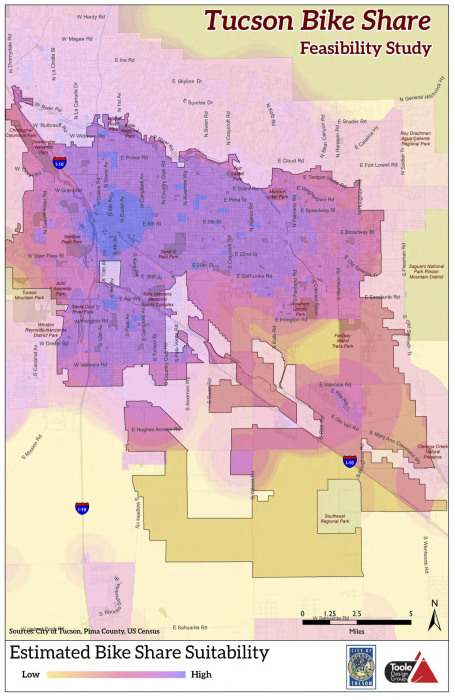
The City of Tucson has released the bike share study that determined it was feasible to start a bike share system in downtown Tucson.
The 28-page report analyzes physical conditions and topography, population density and housing, employment density, colleges and student populations, visitors and tourism, transportation, including transit, car share, and regional transportation, bicycling infrastructure and concludes:
Based on the community analysis, bike share is feasible in Tucson. The area including Downtown Tucson and the University of Arizona displays many of the characteristics considered important for a successful bike share system. There are other parts of Tucson that may support future phases of the system including southeast along the Arroyo-Chico trail to Reid Park, east along Broadway extending to the medical campuses and hotels in that area; corridors north and south of downtown, parts of southern Tucson focused on connecting people to jobs in the technology and aerospace industry around the International Airport and Air Force Base; and in north Tucson along the Loop Trail to connect users to the Tohono Tadai Transit Center, nearby commercial and office land uses, and recreational uses.
Some of the potential users of bike share in Tucson include:
- Residents living in the service area using the system to access local services, destinations, restaurants, and entertainment venues.
- Commuters traveling to the service area making first and final mile connections to and from streetcar or other transit and those that drive into Downtown and want a way to move about throughout the day.
- Students, staff and faculty of the University of Arizona or other colleges making first and final mile connections to and from streetcar or other transit, to access nearby commercial districts, restaurants, and entertainment venues, and to connect between campus and student housing.
- Visitors to Tucson connecting from their hotels to visitor attractions, commercial districts, recreational opportunities, and transportation to take them to further afield attractions.
- Visitors to sporting events, campus visits and tours, or arts and cultural attractions on the University of Arizona campus.
- Business travelers connecting from their hotels to meeting spaces, the Convention Center, restaurants and entertainment venues, and recreational opportunities.
The primary challenges of establishing a bike share system in Tucson include:
-
Low population and employment densities in areas outside of the downtown core may present a challenge for implementing bike share in these areas and stations will need to be more strategically located in these areas and focused around specific attractions or activity centers.
-
Many of Tucson’s major visitor attractions and hotels are outside the range of the bike share system and marketing to tourists and visitors tends to be more expensive as it requires additional outreach beyond standard digital marketing.
-
Single occupant motor vehicle travel is still a high portion of trip-making in the region. Parking is generally low cost and encourages driving, although parking prices are increasing in the downtown area and meters will be introduced on 4th Avenue.
-
There are still many streets in Tucson that are less comfortable for new and inexperienced bicyclists. The City of Tucson and Pima County continue to expand bicycling infrastructure and the initial system can be planned around existing bicycling facilities.
-
Extremely hot weather during the summer could have an impact on ridership and will likely result in lower demands on extremely hot days.
-
Steep topography in areas such as the Catalina Foothills.
